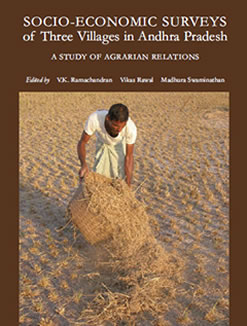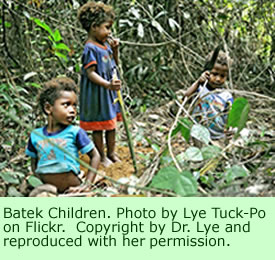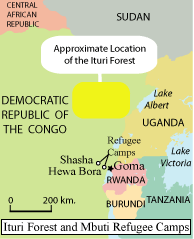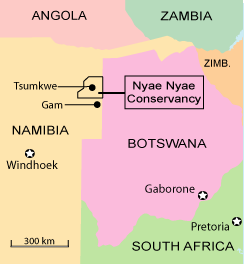Naxalite sabotage of an Indian express train late last week killed over 100 people and heightened tensions over the treatment of the Birhor and the other tribal peoples of eastern India. Media around the world carried the story of the horrible railway accident, and the increased severity of recent battles between the Naxalite Maoist rebel group responsible for the sabotage and security forces. But the Indian press has covered the details of recent violence, and the sometimes brutal police responses, in much greater detail.
For instance, on May 18th, a report came out about the police follow-up to a Naxalite attack at the beginning of the month. The security people in Andhra Pradesh allegedly surrounded an Adivasi (tribal) village after the fighting had ended and rounded up 17 villagers at random, assuming they were all at least sympathizers to the Naxalite cause. The tribals were beaten, dragged two km, bundled into a helicopter, blindfolded, and taken to a police station a distance away. The newspaper interviewed four of the villagers.
“They tied our hands behind our back and repeatedly struck us with lathis,” said one victim, who was covered with bruises from the police treatment. “They kept asking us about Maoists, but we couldn’t understand what they were saying.” The people speak only their tribal tongue, and don’t understand Hindi or the other major Indian languages.
The newspaper reporter talked to the police as well as the tribal people. The police spokesman admitted that they had interviewed the villagers, but he denied that people had been beaten. Discrimination against tribal peoples has been well-known, and humanitarian groups have become involved. The Amnesty International office in New Delhi weighed in on May 22 to condemn the killing of an Adivasi leader during a demonstration in Orissa state. Over 1,000 villagers had gathered to protest the government’s condemnation of their farms for the construction of a steel plant by a South Korean firm. AI reminded officials that they must honor international human rights standards and be careful to not use excessive force.
 The Foundation for Agrarian Studies in India joined the discussion last week by issuing a detailed report, titled Socio-Economic Surveys of Three Villages in Andhra Pradesh: A Study of Agrarian Relations, which analyses the social and economic discrimination that exists in rural India. It is a follow-up to analyses that were reported in June and October 2009—and others. The thrust of the latest study is that discrimination, and a sense of injustice, pervade the treatment of rural agriculturalists, particularly the Adivasi peoples. The fact that simmering resentment has resulted in violent resistance is not surprising.
The Foundation for Agrarian Studies in India joined the discussion last week by issuing a detailed report, titled Socio-Economic Surveys of Three Villages in Andhra Pradesh: A Study of Agrarian Relations, which analyses the social and economic discrimination that exists in rural India. It is a follow-up to analyses that were reported in June and October 2009—and others. The thrust of the latest study is that discrimination, and a sense of injustice, pervade the treatment of rural agriculturalists, particularly the Adivasi peoples. The fact that simmering resentment has resulted in violent resistance is not surprising.
The latest study surveyed three villages in Andhra Pradesh. It found that the income of the Adivasi villagers was much lower than the incomes of other, rural farmers. The more prosperous landowners incurred much lower costs than the landless, Adivasi peasants, who had to pay exorbitant rents for the lands they leased. The degree of landlessness and inequality in the state was surprising, and the situation has gotten worse over the years. Also, the state has neglected making investments in their agricultural sector.
The study concluded that the Adivasi and Muslim villages have been the most discriminated against in the state. Their income is half that of the people in neighboring villages. In the three communities studied, not one house was judged to be even adequate, and many are severely deficient. Only five percent have toilets, and four percent have a source of water. Their levels of education are also exceptionally low.
Everything is not hopeless among the rural tribal people, of course. Another news report last week carried a story about a pioneering silk cultivation project in Jharkhand state, one which appears to be drawing disaffected Adivasi into profitable employment. A local entrepreneur, Arjun Munda, himself a tribal, started a silk industry in the forests of Jharkhand in 2004. At first, he employed just 23 farmers who produced 19 tons of silk.
The operation has grown to where it now employs thousands of tribal people, who turn out 700 tons per year, 40 percent of India’s total silk production. Dhirendra Kumar, a state official, argues that investments in better equipment will allow the industry to grow to 900 tons of production by next year.
The reporter talked with a Birhor man working on a silk plantation. He still had a visible scar from a bullet wound he had gotten from an encounter two years ago. He said he was glad to give away his rifle and take the job. It is evident from the article that at least that one Birhor individual had abandoned the peaceful values of his society and joined the Naxalite cause, at least temporarily. Mr. Kumar told the reporter that he is constantly getting calls from within Naxalite areas, from people interested in working in silk production. Officials are beginning to be welcomed into villages which formerly they did not dare approach.
The silk is being sold as nonviolent and organic, since the variety grown in Jharkhand is not based on mulberry trees. Instead, the farmers grow the silk worms on Sal, Arjuna, and Saja trees, without using any chemicals. The extra-fine silk is commanding higher prices in the markets.
Meanwhile, late last week, as the police ramp up their violent responses to the Maoists, and the Naxalites increase the severity of their attacks, many innocent people are suffering. The express sleeper train left Kolkata (Calcutta) late Thursday evening bound for Mumbai (Bombay), preceded by an engine that was supposed to ensure its security. About 150 km to the west, the engine operator on the express train reported a loud noise, the tracks separated, and the train derailed.
Several of the cars were thrown onto a parallel track, where, a few minutes later, they were hit and crushed by an oncoming freight train. A Naxalite poster was found at the scene of the carnage. A horrible statement of terrorism, forced on people who were, up to the moment, enjoying an overnight luxury train ride. A terrible price to pay in a society blessed with many advances that are often not shared wisely.

 Muhindo Mupepe, an Mbuti representative at the Hewa Bora camp, about 16 km west of Goma, says that they sleep on bare, volcanic rock, the outflows of volcanoes in the area. “Our life here is one of suffering,” he said. “We don’t get any assistance like the other displaced people. When our children fall ill, we have to go and search for medicinal plants in the forest.” The photo that accompanies the story shows a man seated in front of a hut made of sticks with a spectacular, but bleak looking, volcanic landscape in the background.
Muhindo Mupepe, an Mbuti representative at the Hewa Bora camp, about 16 km west of Goma, says that they sleep on bare, volcanic rock, the outflows of volcanoes in the area. “Our life here is one of suffering,” he said. “We don’t get any assistance like the other displaced people. When our children fall ill, we have to go and search for medicinal plants in the forest.” The photo that accompanies the story shows a man seated in front of a hut made of sticks with a spectacular, but bleak looking, volcanic landscape in the background.
 In
In  Inuit spokespersons are not keeping quiet. Abraham Kublu, the mayor of Pond Inlet, a village at the northern end of Baffin Island, condemned the idea of drilling in Arctic waters. Global warming, he says, is increasing the numbers of icebergs in the seas, and the currents are too strong for safe drilling. The Canadian government is spending large amounts of money in the search for oil and other minerals in the Arctic.
Inuit spokespersons are not keeping quiet. Abraham Kublu, the mayor of Pond Inlet, a village at the northern end of Baffin Island, condemned the idea of drilling in Arctic waters. Global warming, he says, is increasing the numbers of icebergs in the seas, and the currents are too strong for safe drilling. The Canadian government is spending large amounts of money in the search for oil and other minerals in the Arctic.